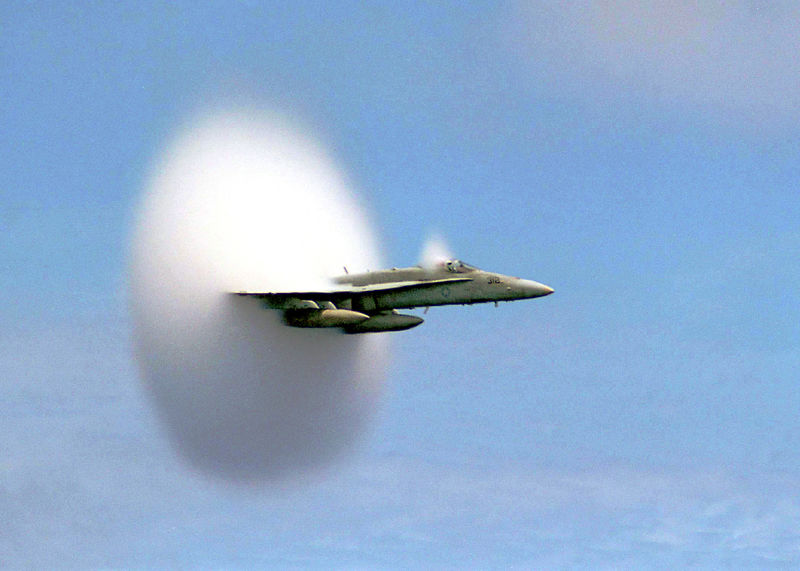
BREAKING THE SOUND BARRIER

In aerodynamics, the sound barrier is the transition at transonic speeds from subsonic to supersonic travel (usually refers to flight). The Sound Barrier was once believed to be a physical barrier preventing large objects from traveling faster than sound. The term came into use during World War II when a number of aircraft started to encounter the effects of compressibility, a grab-bag of unrelated aerodynamic effects, and fell out of use in the 1950s when aircraft started to routinely "break" the sound barrier
The bullwhip or stockwhip was probably the first human-made object to move faster than sound. The tip of the whip breaks the sound barrier and causes a sharp crack--literally a sonic boom. Many forms of ammunition also achieve supersonic speeds.
The tip of the propeller on many World War I aircraft may reach supersonic speeds, producing a noticeable buzz that differentiates such aircraft. This is particularly noticeable on the Stearman. Note that this is infact undesireable as the transonic air movement creates disruptive shock waves and turbulance.
The sound barrier was first broken in a vehicle in a sustained way on land in 1948 by a rocket-powered test vehicle at Muroc Air Force Base (now Edwards AFB) in California. It was powered by 50,000 pounds of thrust, reaching 1,019 mph [1].
For human flight, it is believed that several fighter aircraft of the Second World War, in particular the Supermarine Spitfire, exceeded the sound barrier while diving. However, because it is likely that getting close to this speed in these aircraft would cause the aircraft to become uncontrollable and crash, none of the pilots of these flights would have survived, leaving the tale unsolved.
Why the loss of control? The increased speed caused a shockwave to form on the wing and tail, and as the speed increases this shock wave moves back along the wing and tail. This changes the pressure distribution on the aerodynamic surfaces, and can reverse the effect of the ailerons and elevators. It was this effect that is thought to have caused the crash which killed Geoffrey de Havilland Jr, in the middle of flight testing the DH.108, de Havilland Swallow. The flights were close to or possibly achieved the speed of sound, but since they ended in tragedy, it was in no way useful to the advancement of supersonic flight.
In 1942 the United Kingdom's Ministry of Aviation began a top secret project with Miles Aircraft to develop the world's first aircraft capable of breaking the sound barrier. The project resulted in the development of the prototype Miles M.52 jet aircraft, which was designed to reach 1,000 mph (417 m/s; 1,600 km/h) at 36,000 feet (11 km) in 1 minute 30 seconds.
The aircraft's design was revolutionary introducing many innovations which are still used on today's supersonic aircraft. The single most important development was the all-moving tailplane giving extra control to counteract the Mach tuck which allowed control to be maintained at supersonic speeds; this was the brainchild of Dennis Bancroft and his team at Miles Research. The project was cancelled by the Director of Scientific Research, Sir Ben Lockspeiser, before any piloted flights were conducted. Subsequently, on government orders, all design data and research regarding the Miles M.52 was sent to BELL aircraft in the USA.There was an agreement for data exchange in both directions, but, after receiving the British data, the American government blocked the deal. Later experimentation on the Miles M.52 design proved that the aircraft would indeed have broken the sound barrier, with an unpiloted 3/10 scale replica of the M.52 achieving Mach 1.5 in October 1948.
Hans Guido Mutke claimed to have broken the sound barrier before Yeager, on April 9, 1945 in a Messerschmitt Me 262. However, this claim is widely disputed by most experts as the Me 262's stucture could not support high transonic, let alone supersonic, flight and thus this claim lacks a plausible scientific foundation.
George Welch made a plausible but officially unverified claim to have broken the sound barrier on October 1, 1947 while flying an F-86 Sabre. He also claimed to have repeated his supersonic flight on October 14, 1947, 30 minutes before Chuck Yeager broke the sound barrier in the Bell X-1 using the adjustable tail concept. Although evidence from witnesses and instruments strongly imply that Welch achieved supersonic speed, the flights were not properly monitored and cannot be officially recognized. (The XP-86 officially achieved supersonic speed on April 26, 1948.)
Chuck Yeager was the first person to break the sound barrier in level flight on October 14, 1947, flying the experimental Bell X-1 at Mach 1 at an altitude of 45,000 feet (13.7 km).
Jackie Cochran was the first woman to break the sound barrier on May 18, 1953 in a Canadair F-86 Sabre.
Although the Concorde and Tu-144 were certainly the first aircraft to carry commercial passengers at supersonic speeds, they were not the first or only commercial airliners to break the sound barrier. On August 21, 1961 a Douglas DC-8 broke the sound barrier at Mach 1.012 or 660 mph while in a controlled dive through 41,088 feet. The purpose of the flight was to collect data on a new leading-edge design for the wing. Boeing reports that the 747 broke the sound barrier during certification tests. A China Airlines 747 almost certainly broke the sound barrier in an unplanned descent from 41 000 feet to 9500 feet after an in-flight upset on 19 February 1985. It also reached over 5g. [2]
On October 15, 1997, in a vehicle designed and built by a team led by Richard Noble, driver Andy Green became the first person to break the sound barrier in a land vehicle. The vehicle called the ThrustSSC ("Super Sonic Car"), captured the record almost exactly 50 years after Yeager's flight.